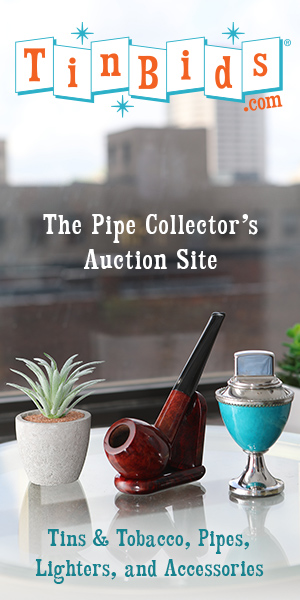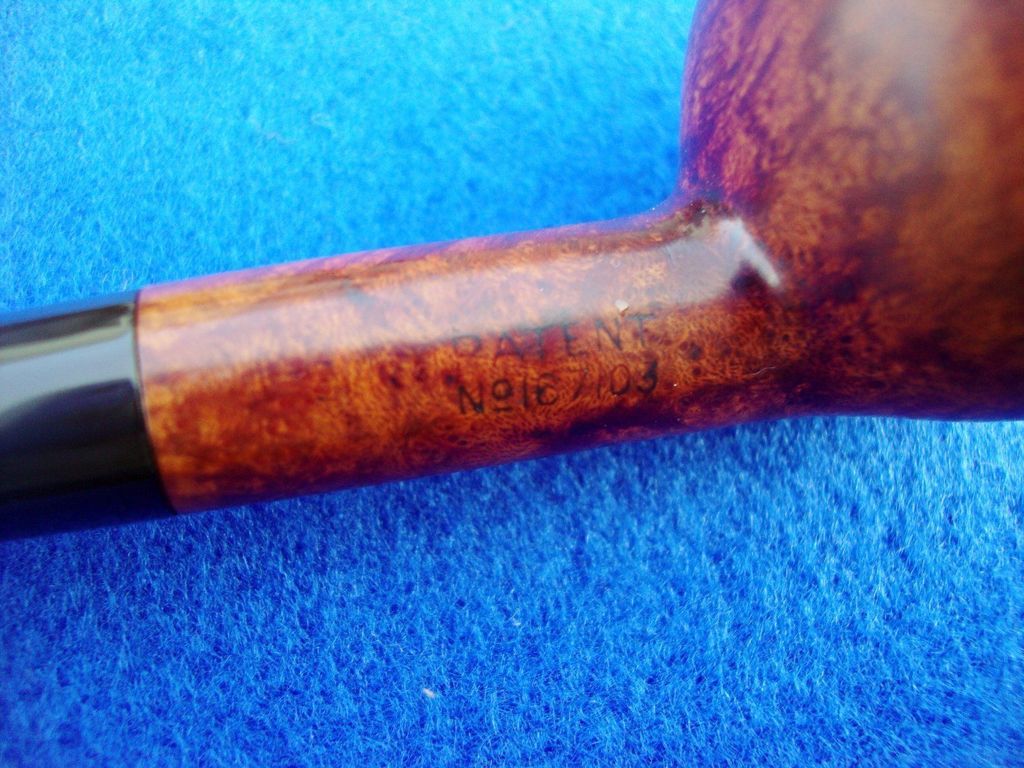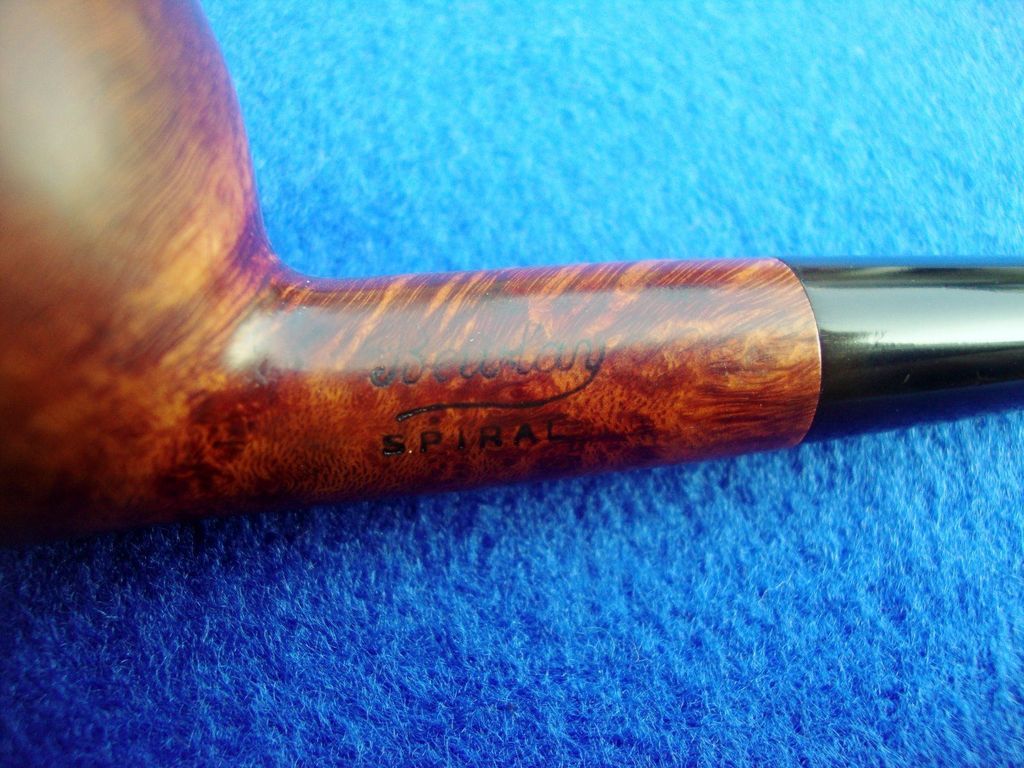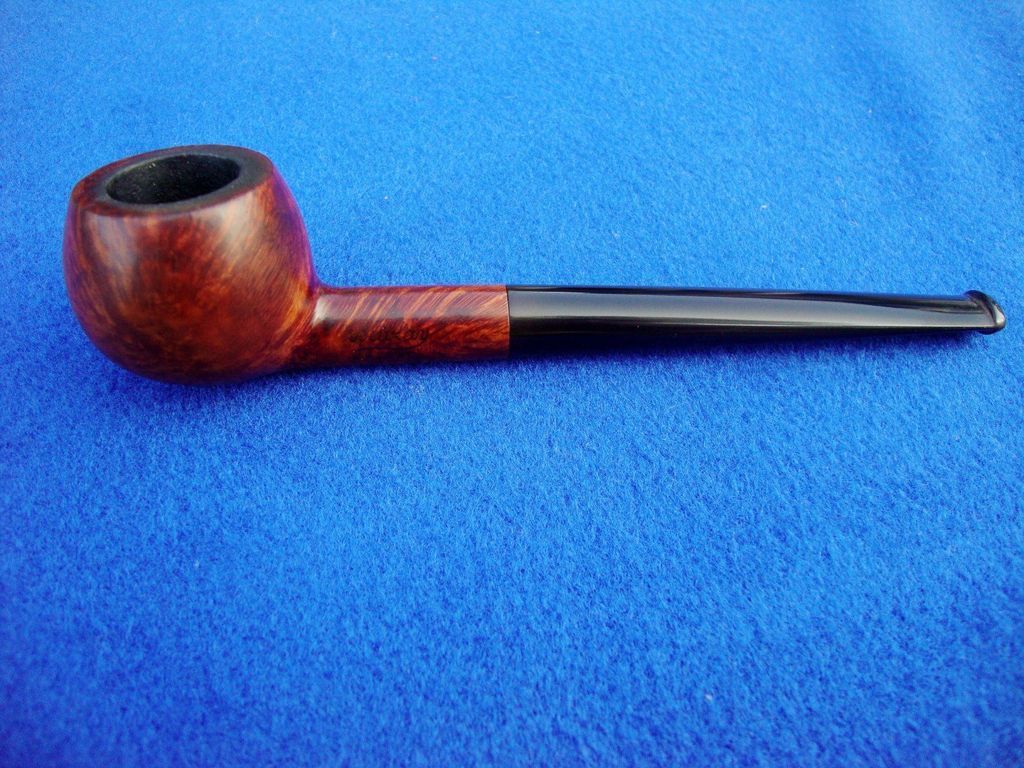A Bewlay Pipe Thread With Pictures
- Thread starter owen
- Start date
You are using an out of date browser. It may not display this or other websites correctly.
You should upgrade or use an alternative browser.
You should upgrade or use an alternative browser.
SmokingPipes.com Updates
Watch for Updates Twice a Week
- Status
- Not open for further replies.
This has developed into an intensely excellent thread gents,
thank you.
:clap:
I can't add much,
but offer a few images.
Here are some 2nds from a 1939 tobacconist's catalog:




 And here's an advert from 1940,
And here's an advert from 1940,
take note that the bowls appear to be uncoated:






thank you.
:clap:
I can't add much,
but offer a few images.
Here are some 2nds from a 1939 tobacconist's catalog:





take note that the bowls appear to be uncoated:






Probably an error on the tobacconist's part, I forget exactly whom put out the catalog off the top of my head, but it also illustrates an issue that Jon has brought up, namely that sometimes in the case of advertising or catalogs, old images can be utilized, and that appears to be the case here, were they still making one-dots in 1939?Troy, in the series of 1939 pictures the HRH actually appears to be a One Dot. Someone at Sasieni didn't proofread that catalog well enough! :D
In any event, caution and skepticism is a prerequisite for serious research, and before any definitive claims are made, it's always a good idea to list "possible alternatives" in conjunction with one's theories, just to try and cover all the bases, as it were.
:
 :
:Only one has what I'd call a visible fill, Owen - the large bent, which I purchased from Canada. Might have been one of the later exports. Bewlay's patented these pipes in Canada, but I've yet to see the CA# on a pipe. The first three I posted plus a Canadian are the only ones with completely clean briar. The rest have one or two pinpoint fills that take awhile to find.
Here's a few adverts. This one from 1909 seems to imply that the company has their own pipe maker, always on call as it were. Wonder who?




Here's a few adverts. This one from 1909 seems to imply that the company has their own pipe maker, always on call as it were. Wonder who?




This is one of the coolest looking Bewlay pipes that I've ever seen,
it was made by Barling:
http://shuzed.blog104.fc2.com/blog-entry-197.html
:
A Comoy-made Bewlay;
 :
:
A Bewlay's walking stick circa 1892:
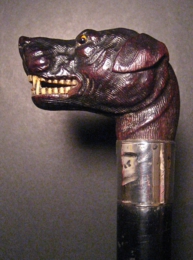
As found here:
http://www.anti-q.jp/annexe/canemania.html
:
That 1890's price list seen earlier in this thread is in the holdings of Historic New England/Otis House in Boston Mass. as part of the ephemera collection. I wonder if viewings are available? Anybody here in Boston? 8)
See here:
http://www.historicnewengland.org/collections-archives-exhibitions/collections-access/collection-object/capobject?refd=EP001.12.016.042
:
The only English patent filing that I could find for Bewlay is GB189386 from 1922:
http://worldwide.espacenet.com/publicationDetails/originalDocument?CC=GB&NR=189386A&KC=A&FT=D&ND=3&date=19221130&DB=EPODOC&locale=en_EP
: :
:
it was made by Barling:
http://shuzed.blog104.fc2.com/blog-entry-197.html
:
A Comoy-made Bewlay;

A Bewlay's walking stick circa 1892:

As found here:
http://www.anti-q.jp/annexe/canemania.html
:
That 1890's price list seen earlier in this thread is in the holdings of Historic New England/Otis House in Boston Mass. as part of the ephemera collection. I wonder if viewings are available? Anybody here in Boston? 8)
See here:
http://www.historicnewengland.org/collections-archives-exhibitions/collections-access/collection-object/capobject?refd=EP001.12.016.042
:
The only English patent filing that I could find for Bewlay is GB189386 from 1922:
http://worldwide.espacenet.com/publicationDetails/originalDocument?CC=GB&NR=189386A&KC=A&FT=D&ND=3&date=19221130&DB=EPODOC&locale=en_EP
:
 :
:Continuing the story...
Having no luck at the cigar factories, I tried Sandys Row Synagogue, another venue where the two families might have forged a lasting relationship. Its founders were a group of fifty families of Dutch Jews from the Tenter Ground, who were determined to establish a synagogue of their own in London's East End. The participation of the Sasieni family seemed likely. I tried a few searches using the various spellings, and actually found something: a newsletter from the London Chorale Society dated 1875, which announced that a Moses Sassieni of 16 Freeman Street had applied for a paid position as a tenor in the choir of Sandys Row Synagogue, of which he was already a member, at the stipend of five pounds per annum.
The synagogue formally opened to the public in 1880, and its doors haven't closed since. I visited their website, which has a database of marriaige records covering this period, and found matches for both Sasieni(55) and Elkan(27). I balked at making an advanced search however, since this required a substantial donation, and I was more interested in membership records. Even then, if I were able discover that Baron Elkan, Albert Bessie, Stanley Phillips actually were on the list, would it prove anything?
Dutch Jews did not speak Yiddish as a rule, which isolated them from the larger Jewish immigrant community which used it as a shared tongue. Most made no attempt to learn it, since there was a greater imperative toward mastering English. So the Dutch immigrants appeared standoffish. In addition they traditionally ate tidal seafood like clams and mussels, which weren't kosher. So they didn't seem all that Jewish either. The other Jews called them "chuts", which wasn't derogatory apparently, and translates as "happy".
They wouldn't say much. Just smile.
The synagogue quickly grew its membership to include the entire Jewish community however, topping out at 450 families, and since services were held in Hebrew, all Jews were equal. It became a revered institution among the working class Jews in Whitechapel, and as a result of fundraising for its charitable work, I suspect that the Jewish merchants who employed them would have come under pressure to support Sandys Row Synagogue as well.
Here's a 1919 B&Co PAT APPLIED FOR from Sasieni's first year of production. The stamp on the bottom of the shank appears identical to that seen on the Spiral pre-patent posted above. Sasieni's provisional patent application did not include drawings, so this might have been made to test market a few different stingers. The one shown is from an early four dot Melton.




Having no luck at the cigar factories, I tried Sandys Row Synagogue, another venue where the two families might have forged a lasting relationship. Its founders were a group of fifty families of Dutch Jews from the Tenter Ground, who were determined to establish a synagogue of their own in London's East End. The participation of the Sasieni family seemed likely. I tried a few searches using the various spellings, and actually found something: a newsletter from the London Chorale Society dated 1875, which announced that a Moses Sassieni of 16 Freeman Street had applied for a paid position as a tenor in the choir of Sandys Row Synagogue, of which he was already a member, at the stipend of five pounds per annum.
The synagogue formally opened to the public in 1880, and its doors haven't closed since. I visited their website, which has a database of marriaige records covering this period, and found matches for both Sasieni(55) and Elkan(27). I balked at making an advanced search however, since this required a substantial donation, and I was more interested in membership records. Even then, if I were able discover that Baron Elkan, Albert Bessie, Stanley Phillips actually were on the list, would it prove anything?
Dutch Jews did not speak Yiddish as a rule, which isolated them from the larger Jewish immigrant community which used it as a shared tongue. Most made no attempt to learn it, since there was a greater imperative toward mastering English. So the Dutch immigrants appeared standoffish. In addition they traditionally ate tidal seafood like clams and mussels, which weren't kosher. So they didn't seem all that Jewish either. The other Jews called them "chuts", which wasn't derogatory apparently, and translates as "happy".
They wouldn't say much. Just smile.
The synagogue quickly grew its membership to include the entire Jewish community however, topping out at 450 families, and since services were held in Hebrew, all Jews were equal. It became a revered institution among the working class Jews in Whitechapel, and as a result of fundraising for its charitable work, I suspect that the Jewish merchants who employed them would have come under pressure to support Sandys Row Synagogue as well.
Here's a 1919 B&Co PAT APPLIED FOR from Sasieni's first year of production. The stamp on the bottom of the shank appears identical to that seen on the Spiral pre-patent posted above. Sasieni's provisional patent application did not include drawings, so this might have been made to test market a few different stingers. The one shown is from an early four dot Melton.




Continuing the story...
Dutch Jews did not speak Yiddish as a rule, which isolated them from the larger Jewish immigrant community where it served as a shared tongue. Most made no attempt to learn it either, since there was a greater imperative toward mastering English. So the Dutch immigrants appeared standoffish. In addition they regularly ate tidal seafood like clams and mussels, which weren't kosher. So they didn't seem all that Jewish. The other Jews called them "chuts", which wasn't derogatory apparently, and translates as "happy".
They wouldn't say much. Just smile.
Having had no luck at the cigar factories, I tried Sandys Row Synagogue, another venue where the Sasieni and Elkan families might have forged a lasting relationship. Its founders were a group of fifty families of Dutch Jews from the Tenter Ground, who were determined to establish a synagogue of their own in London's East End. The participation of the Sasieni family seemed likely. I tried a few searches using the various spellings, and actually found something: a newsletter from the London Chorale Society dated 1875, which announced that a Moses Sassieni of 16 Freeman Street had applied for a paid position as a tenor in the choir of Sandys Row Synagogue, of which he was already a member, at the stipend of five pounds per annum.
The synagogue formally opened to the public in 1880, and its doors haven't closed since. I visited their website, which has a database of marriaige records covering this period, and found matches for both Sasieni(55) and Elkan(27). I balked at making an advanced search however. This required a substantial donation. Enough to buy a couple of nice briars, unfortunately. I was really looking for their membership records, anyway. After searching through the Sasieni census documents, I felt certain that there had been no intermarriage between the families.
Although founded by families of Dutch Jews, the congregation quickly grew to include Poles, Russians, and Germans - the entire Jewish community - with their membership roll topping out around 450 families. Services were held in Hebrew, and all Jews were equal. It became a revered institution among the working class Jews in Whitechapel, and as a result of fundraising for its charitable work, I suspect that the Elkans would have come under considerable pressure to support Sandys Row Synagogue as well. I have a hard time imagining them wanting to spend their Sabbath in the squalor of Spitalfields, though. They might have paid membership dues as a way of making a donation, but never attended services.
Even if I were able determine that Alexander Elkan, Baron Elkan, Albert Bessie, or Stanley Phillips were on their membership list, would it prove anything?

Dutch Jews did not speak Yiddish as a rule, which isolated them from the larger Jewish immigrant community where it served as a shared tongue. Most made no attempt to learn it either, since there was a greater imperative toward mastering English. So the Dutch immigrants appeared standoffish. In addition they regularly ate tidal seafood like clams and mussels, which weren't kosher. So they didn't seem all that Jewish. The other Jews called them "chuts", which wasn't derogatory apparently, and translates as "happy".
They wouldn't say much. Just smile.
Having had no luck at the cigar factories, I tried Sandys Row Synagogue, another venue where the Sasieni and Elkan families might have forged a lasting relationship. Its founders were a group of fifty families of Dutch Jews from the Tenter Ground, who were determined to establish a synagogue of their own in London's East End. The participation of the Sasieni family seemed likely. I tried a few searches using the various spellings, and actually found something: a newsletter from the London Chorale Society dated 1875, which announced that a Moses Sassieni of 16 Freeman Street had applied for a paid position as a tenor in the choir of Sandys Row Synagogue, of which he was already a member, at the stipend of five pounds per annum.
The synagogue formally opened to the public in 1880, and its doors haven't closed since. I visited their website, which has a database of marriaige records covering this period, and found matches for both Sasieni(55) and Elkan(27). I balked at making an advanced search however. This required a substantial donation. Enough to buy a couple of nice briars, unfortunately. I was really looking for their membership records, anyway. After searching through the Sasieni census documents, I felt certain that there had been no intermarriage between the families.
Although founded by families of Dutch Jews, the congregation quickly grew to include Poles, Russians, and Germans - the entire Jewish community - with their membership roll topping out around 450 families. Services were held in Hebrew, and all Jews were equal. It became a revered institution among the working class Jews in Whitechapel, and as a result of fundraising for its charitable work, I suspect that the Elkans would have come under considerable pressure to support Sandys Row Synagogue as well. I have a hard time imagining them wanting to spend their Sabbath in the squalor of Spitalfields, though. They might have paid membership dues as a way of making a donation, but never attended services.
Even if I were able determine that Alexander Elkan, Baron Elkan, Albert Bessie, or Stanley Phillips were on their membership list, would it prove anything?

Marvich,
I appreciate all your well-researched historical contributions in this thread.
But honestly,
I don't get what you're trying to say?
Could you possibly condense it into a graspable cohesive narrative?
This is a Bewlay thread, and you've introduced an array of confusing familial interconnections,
what are you attempting to posit?
Make your synopsis brief so that I may understand what you are trying to say.
All the various hereditary offshoots cause confusion on my part.
I am confused.
Please,
tell me what the end goal is.
What are you seeking to establish as fact?
Are you trying to elevate Bewlay pipes into a higher realm?
:?:
I appreciate all your well-researched historical contributions in this thread.
But honestly,
I don't get what you're trying to say?
Could you possibly condense it into a graspable cohesive narrative?
This is a Bewlay thread, and you've introduced an array of confusing familial interconnections,
what are you attempting to posit?
Make your synopsis brief so that I may understand what you are trying to say.
All the various hereditary offshoots cause confusion on my part.
I am confused.
Please,
tell me what the end goal is.
What are you seeking to establish as fact?
Are you trying to elevate Bewlay pipes into a higher realm?
:?:
Yes, my fragmented story has gotten confusing, and I apologize for that.
The point is this: I'm convinced that Bewlay's gave Joel Sasieni his start. I haven't yet proved this, though. Perhaps the forums aren't the place to nail it down. But it's a great story. I was hoping to find help to close the case.
Perhaps I've been remiss in fully explaining the cigar connection. Hunter, Morris and Elkan controlled fully 50% of the UK cigar market at the time of the merger. The other 50% was controlled by the J. Frankau Co., a name more familiar to pipe collectors because of A. Frankau Co.'s BBB pipes.
The Elkans wanted a Louis Blumfeld of their own, is my guess. I think they made Joel Sasieni an offer he couldn't refuse, probably around 1908. Keep our London shops supplied with briars for the next ten years or so, and we'll launch Sasieni pipes in America.
The point is this: I'm convinced that Bewlay's gave Joel Sasieni his start. I haven't yet proved this, though. Perhaps the forums aren't the place to nail it down. But it's a great story. I was hoping to find help to close the case.
Perhaps I've been remiss in fully explaining the cigar connection. Hunter, Morris and Elkan controlled fully 50% of the UK cigar market at the time of the merger. The other 50% was controlled by the J. Frankau Co., a name more familiar to pipe collectors because of A. Frankau Co.'s BBB pipes.
The Elkans wanted a Louis Blumfeld of their own, is my guess. I think they made Joel Sasieni an offer he couldn't refuse, probably around 1908. Keep our London shops supplied with briars for the next ten years or so, and we'll launch Sasieni pipes in America.
Here is a newcomer to be refurbished. All I know is the faint stamping tells me it is a 'Reject', Made In England with a 164 stamp. It is a smidgen over 13cm long.
I presume it is a stack or chimney? It has the most unusual fill material, it is rather like a shiny black resin kind of substance.
Despite the minor fills it has some quite respectable grain and should clean up nicely though I fear I might lose those faint stampings. Does this shape ring any bells with anyone?
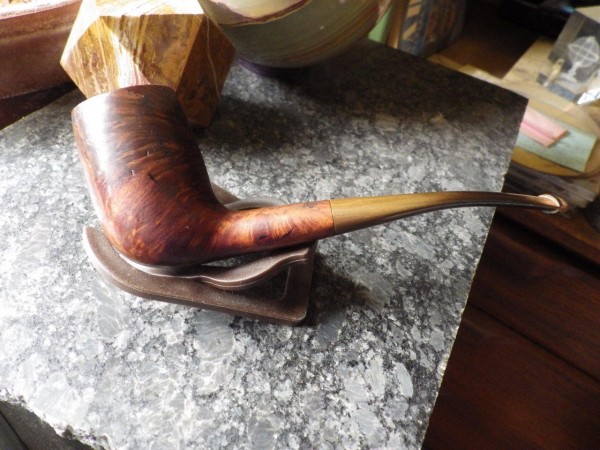
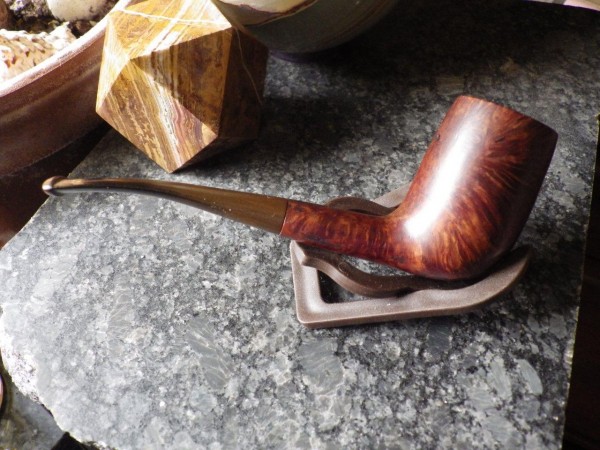
Regards,
Jay.
I presume it is a stack or chimney? It has the most unusual fill material, it is rather like a shiny black resin kind of substance.
Despite the minor fills it has some quite respectable grain and should clean up nicely though I fear I might lose those faint stampings. Does this shape ring any bells with anyone?


Regards,
Jay.
I looked back at my earlier posts to figure out where the confusion might have arisen and discovered I'd posted one bit twice...ughh. My apologies again misterlowercase. I enjoyed seeing those old street view photos. Doesn't your 1898 Barling serve as proof that the Bewlay's brand had already attained an elevated reputation by the turn of the century?
Likewise, the Sasieni-made Bewlay Spiral patents were high quality pipes, and widened the brand's reputation in the 1920's. They were the only family-era pipes produced in significant quantity.
When David Bowie was asked about the title of his album "The Bewlay Brothers" he had to laugh before explaining that it was an inside joke among the members of the band. Turned out each of them had independently purchased a cheap Bewlay pipe. "They were everywhere", he said. So, yes. I'll plead guilty to thinking that the reputation of the Bewlay brand rightly deserves restoration. It's from 1916.
Here's a Bewlay that some buyers might have attributed to Loewe. What do you think?

Likewise, the Sasieni-made Bewlay Spiral patents were high quality pipes, and widened the brand's reputation in the 1920's. They were the only family-era pipes produced in significant quantity.
When David Bowie was asked about the title of his album "The Bewlay Brothers" he had to laugh before explaining that it was an inside joke among the members of the band. Turned out each of them had independently purchased a cheap Bewlay pipe. "They were everywhere", he said. So, yes. I'll plead guilty to thinking that the reputation of the Bewlay brand rightly deserves restoration. It's from 1916.
Here's a Bewlay that some buyers might have attributed to Loewe. What do you think?

Did anyone notice that the Bewlay Spiral was priced higher than Charatan's Underboar in the 1924 Robinson's Singapore advert I posted earlier? $6.50 vs $5.00?
Here's another bit.
Throughout the family era Bewlay & Co. remained a cigar specialist retailer, and prior to the turn of the century they stocked only a limited offering of high end pipes. Since these had to be ordered from the best pipe makers and given custom-made proprietary stampings, they weren't very profitable items for retailers. Nevertheless many prominent merchants followed the practice as forward-looking advertising. High quality briars were being made to last, and offered an enduring way to build the brand.
The worldwide distribution and marketing of cigars was a mature industry when briar pipes began to gain traction in the marketplace, and Bewlay's connections in the cigar trade allowed them to distribute pipes in quantity with a competitive advantage. In addition to their chain of London shops they had a profitable catalog business, shipping their cigars and bulk tobacco to the far corners of the British Empire. Since pipes were headed to the same destinations, they went along for the ride.
Some of this business was seasonal, like the holiday tobacco packets that many expatriate Brits working in the Colonies would receive on Boxing Day. Although they were warned in advance not to expect all the comforts of home at rubber plantations in Malaysia or tin mines in Vietnam, a regular supply of tobacco was non-negotiable. As briar pipes became increasingly popular, demand grew for these be included in the packets as well. Even the non-smokers would receive one, and their pipes became valuable trade items.
Baron Elkan registered Bewlay's B&Co sponsors mark for eight different silversmiths between 1903 and 1910. So the company presumably had some stummels ready to send out to be mounted as early as 1903, and they began manufacturing their own pipes in a small way. When they put the word out that they were seeking to buy stummels, their reputation might have attracted some quality craftsmen. Bewlay could afford to be less picky than other firms buying bowls at the time, such as Barling. Even those with flaws would be coveted in the Colonies.
Here's a 1905 bulldog

Here's another bit.
Throughout the family era Bewlay & Co. remained a cigar specialist retailer, and prior to the turn of the century they stocked only a limited offering of high end pipes. Since these had to be ordered from the best pipe makers and given custom-made proprietary stampings, they weren't very profitable items for retailers. Nevertheless many prominent merchants followed the practice as forward-looking advertising. High quality briars were being made to last, and offered an enduring way to build the brand.
The worldwide distribution and marketing of cigars was a mature industry when briar pipes began to gain traction in the marketplace, and Bewlay's connections in the cigar trade allowed them to distribute pipes in quantity with a competitive advantage. In addition to their chain of London shops they had a profitable catalog business, shipping their cigars and bulk tobacco to the far corners of the British Empire. Since pipes were headed to the same destinations, they went along for the ride.
Some of this business was seasonal, like the holiday tobacco packets that many expatriate Brits working in the Colonies would receive on Boxing Day. Although they were warned in advance not to expect all the comforts of home at rubber plantations in Malaysia or tin mines in Vietnam, a regular supply of tobacco was non-negotiable. As briar pipes became increasingly popular, demand grew for these be included in the packets as well. Even the non-smokers would receive one, and their pipes became valuable trade items.
Baron Elkan registered Bewlay's B&Co sponsors mark for eight different silversmiths between 1903 and 1910. So the company presumably had some stummels ready to send out to be mounted as early as 1903, and they began manufacturing their own pipes in a small way. When they put the word out that they were seeking to buy stummels, their reputation might have attracted some quality craftsmen. Bewlay could afford to be less picky than other firms buying bowls at the time, such as Barling. Even those with flaws would be coveted in the Colonies.
Here's a 1905 bulldog

I received this via email.
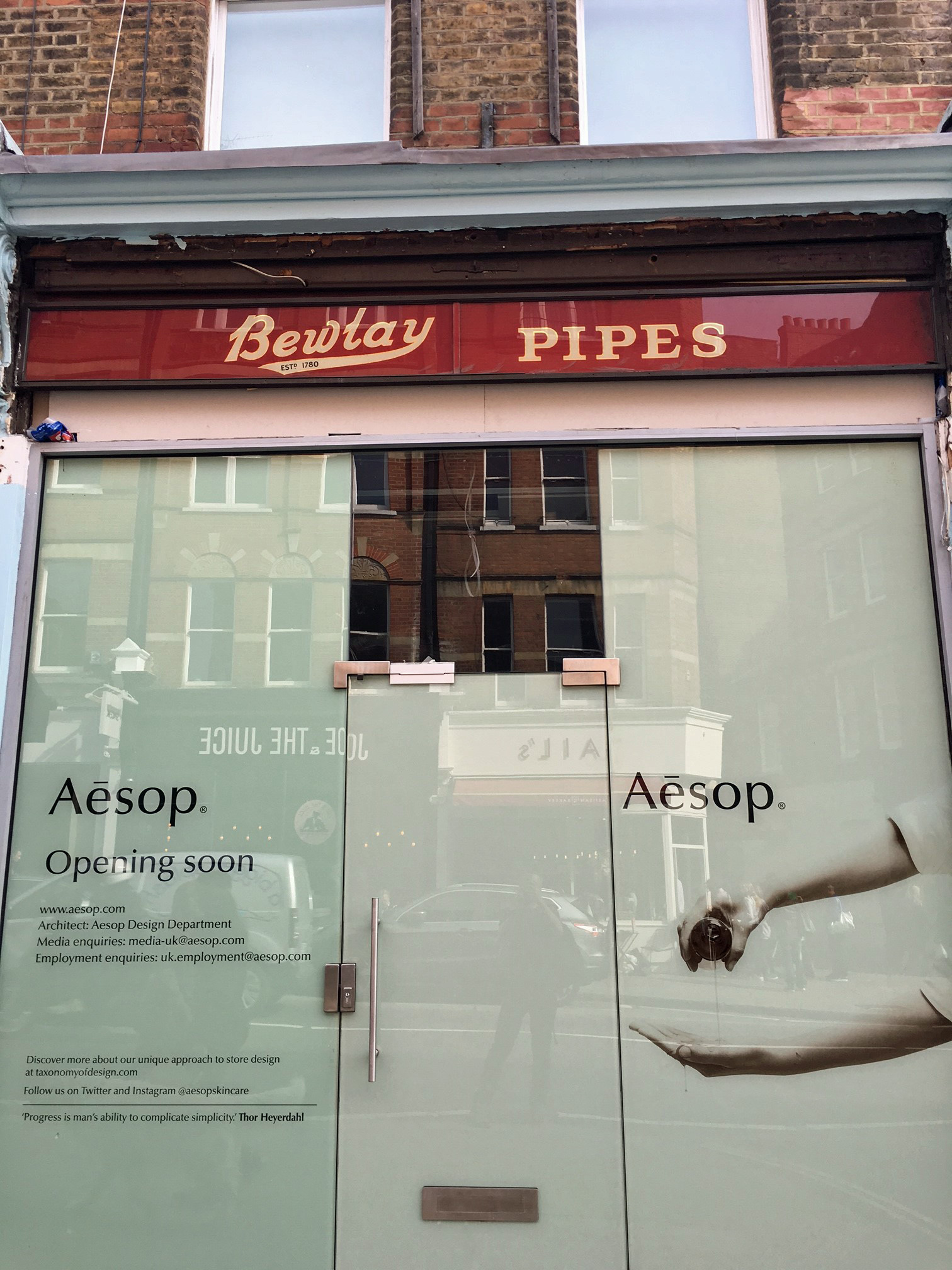
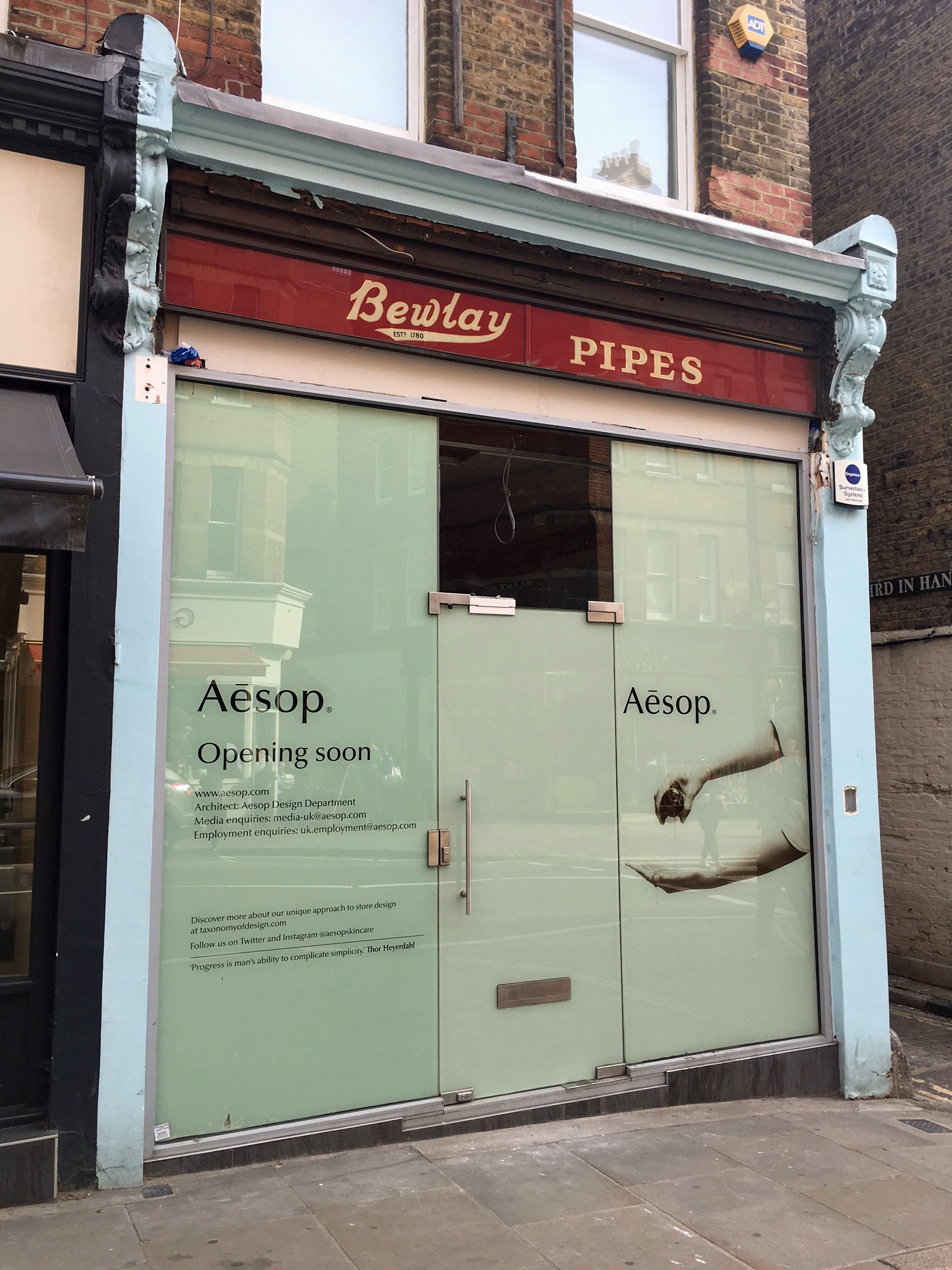
I just thought that I would pass on a couple of photos that may or may not be of interest to your members.
I live in Hampstead London and noticed today that during a refurbishment of a shop has exposed some original Bewlay Pipe signage still in great condition. I am not sure if this is particularly rare but I thought it looked great and hoped it may be of some interest to you.
I am interested in old signage but also wanted to document it as it will probably be covered up again within the next day or two.
Cheers
Wayne Bilton


Very cool, but a shame as I'm sure they'll just cover over it. But, at least we have the picture!
- Status
- Not open for further replies.




